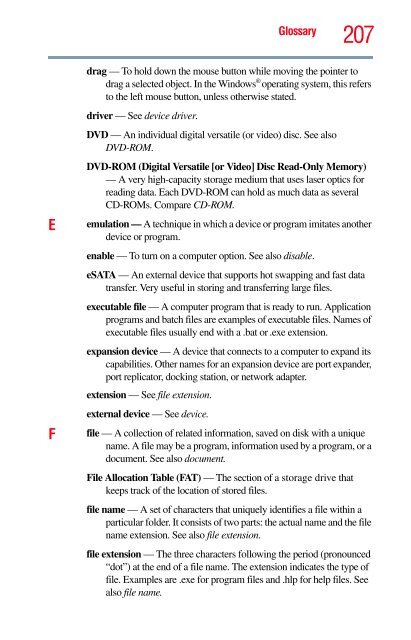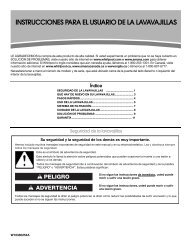Satellite® T210/T230 Series User's Guide - Howard Computers
Satellite® T210/T230 Series User's Guide - Howard Computers
Satellite® T210/T230 Series User's Guide - Howard Computers
You also want an ePaper? Increase the reach of your titles
YUMPU automatically turns print PDFs into web optimized ePapers that Google loves.
E<br />
F<br />
Glossary 207<br />
drag — To hold down the mouse button while moving the pointer to<br />
drag a selected object. In the Windows ® operating system, this refers<br />
to the left mouse button, unless otherwise stated.<br />
driver — See device driver.<br />
DVD — An individual digital versatile (or video) disc. See also<br />
DVD-ROM.<br />
DVD-ROM (Digital Versatile [or Video] Disc Read-Only Memory)<br />
— A very high-capacity storage medium that uses laser optics for<br />
reading data. Each DVD-ROM can hold as much data as several<br />
CD-ROMs. Compare CD-ROM.<br />
emulation — A technique in which a device or program imitates another<br />
device or program.<br />
enable — To turn on a computer option. See also disable.<br />
eSATA — An external device that supports hot swapping and fast data<br />
transfer. Very useful in storing and transferring large files.<br />
executable file — A computer program that is ready to run. Application<br />
programs and batch files are examples of executable files. Names of<br />
executable files usually end with a .bat or .exe extension.<br />
expansion device — A device that connects to a computer to expand its<br />
capabilities. Other names for an expansion device are port expander,<br />
port replicator, docking station, or network adapter.<br />
extension — See file extension.<br />
external device — See device.<br />
file — A collection of related information, saved on disk with a unique<br />
name. A file may be a program, information used by a program, or a<br />
document. See also document.<br />
File Allocation Table (FAT) — The section of a storage drive that<br />
keeps track of the location of stored files.<br />
file name — A set of characters that uniquely identifies a file within a<br />
particular folder. It consists of two parts: the actual name and the file<br />
name extension. See also file extension.<br />
file extension — The three characters following the period (pronounced<br />
“dot”) at the end of a file name. The extension indicates the type of<br />
file. Examples are .exe for program files and .hlp for help files. See<br />
also file name.
















